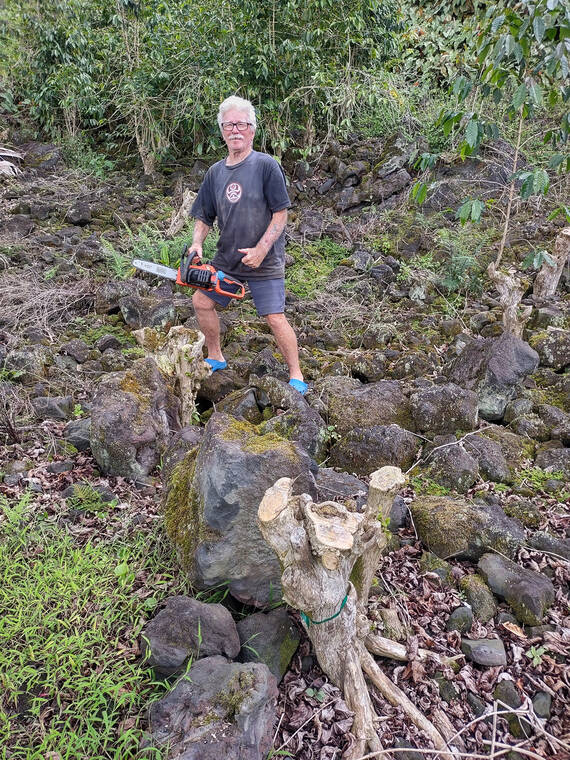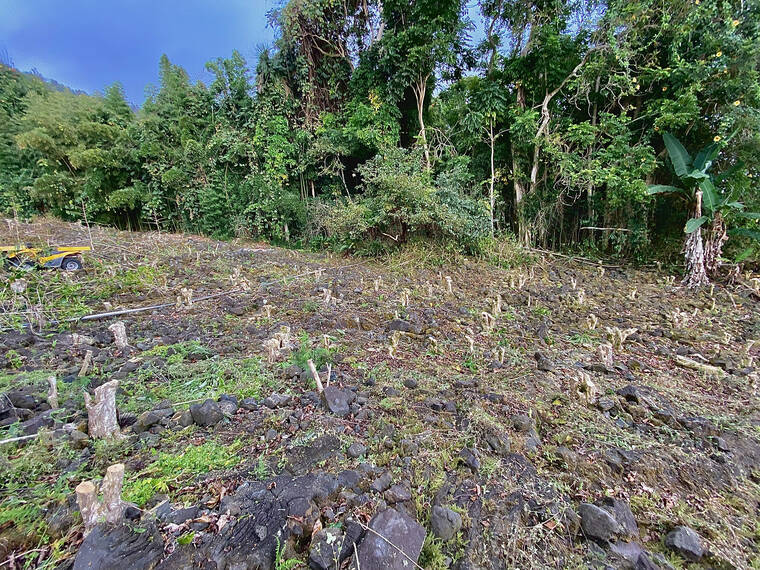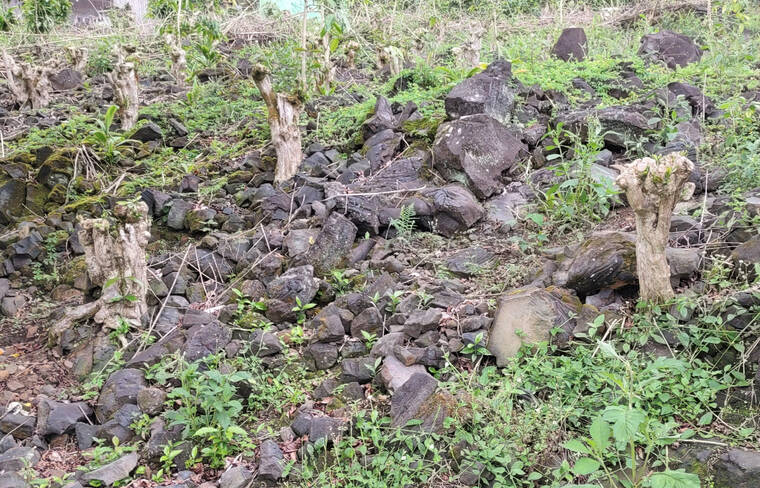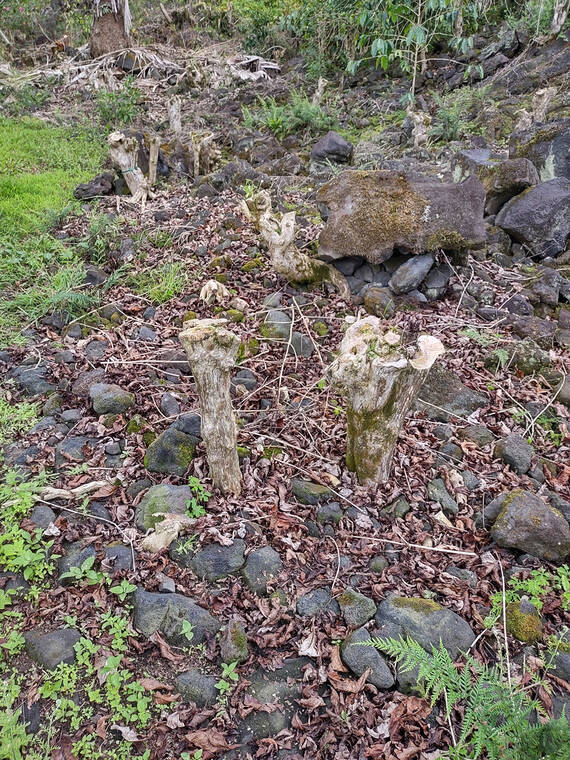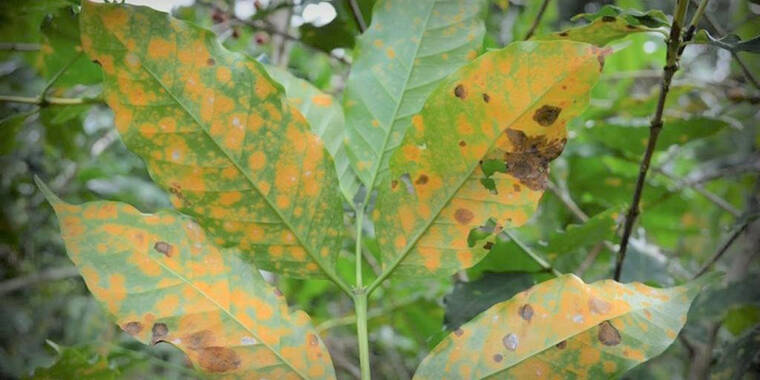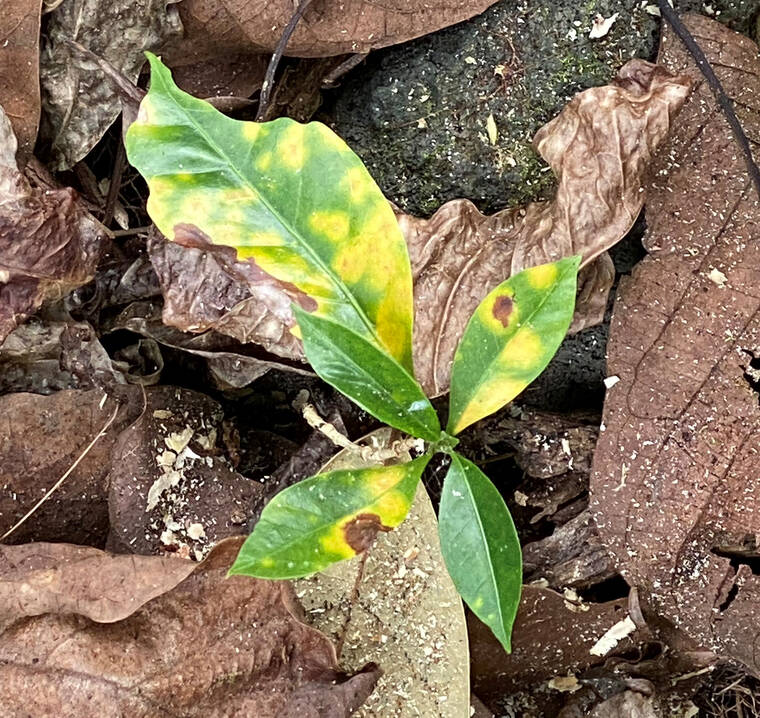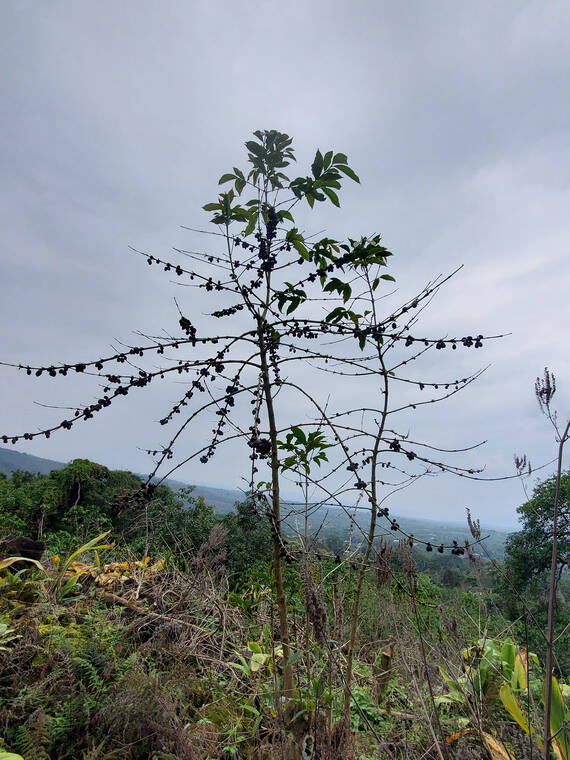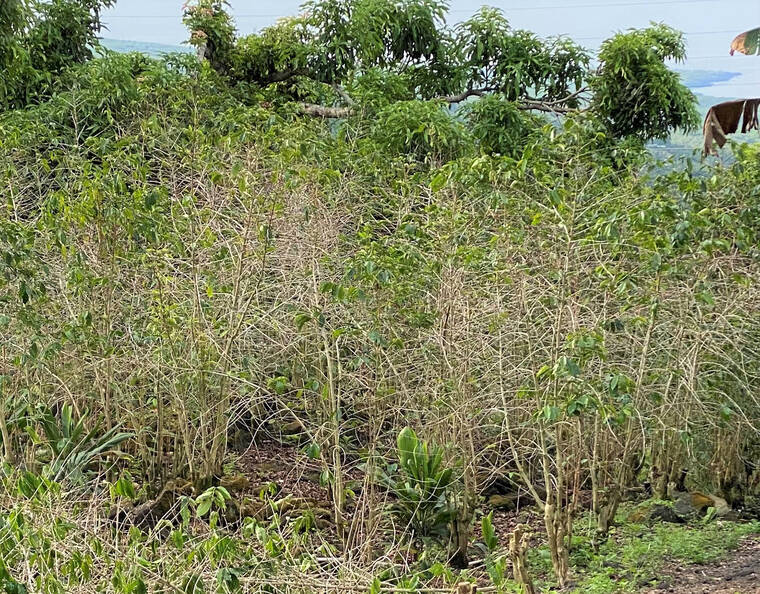In a recent conversation with three farmers living in my old neighborhood on Rabbit Hill Road in South Kona, I realized that Kona Coffee has a dubious future. My experience is that farmers are a resourceful bunch. Always faced with new challenges, they move forward or sideways trying not to let the latest problem get them down or cause them to quit farming. However, these farmers feel that their livelihood has been severely threatened in the last few years.
Barry Williamson pointed out that coffee farmers on Rabbit Hill Road are trying different techniques to deal with the most recent and perhaps most destructive pest, coffee leaf rust (CLR).
Barry is completely stumping his trees. His neighbors, new farmers Mark and Lelia Wessels, are trying to control the disease by following the University of Hawaii recommendations for applying fungicides. My friend Kim Johnson from Left Coast Farm is doing a partial stumping of her trees.
Kim reports that she is going onto her coffee land with a chain saw in one hand and a handkerchief in the other. She decided to remove all but one upright on each of her trees.
“Cutting my trees after 25 years of cultivating them, is heartbreaking,” she reports.
Mark and Lelia started spraying in 2021 and have continued with the UH protocol this spring.
Mark did admit, “Since CLR is still rampant in my orchard, I may end up stumping my trees rather than spend the time and money on spraying next year.”
Coffee leaf rust is a disease that follows several other introduced pest problems that have plagued Hawaii coffee farmers over the last few decades.
The black twig borer, Xylosandrus compactus was, accidently introduced on Oahu in 1961. It proceeded to spread to other islands and attack over 100 different plant species including coffee. The twig borer causes die back in some branches but when controlled does not severely threaten coffee production.
Next came a painful threat to farming in Kona. In 1999, the little fire ant, Wasmannia auropunctata, was discovered on the Big Island. Known as LFA, these ants tend to move on the upper branches of trees, like coffee. When disturbed, the ants can fall on coffee farmers and pickers and sting repeatedly. Their sting is very painful and can cause an allergic reaction. Severe reactions include painful welts, but can also cause anaphylactic shock. Control of these ants is difficult and expensive and definitely discourages harvesting of coffee in affected areas.
Less than a decade later, the coffee berry borer of CBB, Hypothenemus hampei, was discovered in Kona in 2010. The adult female CBB lays her eggs in immature coffee berries. They hatch and the young beetle starts eating, destroying at least one of the beans.
Because the CBB spends most of its life cycle inside the berry, it is very difficult to control. Traps, as well as sanitation techniques and several pesticides including an organic one, have helped control this pest, but the practices are time consuming and expensive. Another hit to the Kona coffee farmer.
Currently, Kona coffee farmers are dealing with a devastating a new disease. Coffee leaf rust is a foliar disease of coffee plants caused by the fungus Hemileia vastatrix. It arrived in Kona in late 2020, and has spread quickly throughout coffee growing regions here and in other parts of the island and state.
Coffee leaf rust starts with the appearance of small yellow spots on the upper leaf surface and then powdery yellow to orange spores are produced on the underside of the leaf. Black necrotic areas develop and, in advanced stages, diseased leaves die and drop. This leaves the plant nearly leafless and unable to photosynthesize. At this point the trees may die. Farmers are currently seeking the most effective way to combat the rust. Several different pesticides are available but they are all relatively expensive and labor intensive to apply in an industry that already has a low profit margin.
Together these four pests continue to threaten coffee plants and are posing a severe economic challenge to what was the second largest agricultural commodity in the state in 2021. Farmers on Rabbit Hill Road described the ways they are dealing with this latest challenge.
Barry Williamson of Hale Manu Farm has decided to stump his 1,500 trees. Though the roots seem to be still alive and are producing new growth, the rust still exists on his farm and could attack new leaves as they appear and continue to threaten his plants. Removing all the branches above 18-36 inches on his trees means that it will take at least three years for them to return to full production.
“I don’t want to spend the time and money on pesticides,” he says, “My profit margin was already negligible. Continuing to grow coffee and spray for CLR will mean a financial loss for me.”
Though it is unlikely that his Kona typica trees will come back with a resistance to the fungus, he is doing what he can to improve his soil and the health of plants by mulching and fertilizing.
Barry’s neighbor, Kim Johnson is doing a partial stumping, leaving a single upright branch on each tree. She has also chosen not to spray, but hopes she can get enough coffee for her personal use this way.
When I asked why she wasn’t going the pesticide route, she responded, “I just can’t apply something to my plants that I wouldn’t want to drink in my coffee.”
Mark and Lelia of Domain Kona have been biting the bullet and spending the time and money on pesticide application. “I’m a new coffee farmer and I hate the thought of throwing in the towel so soon.” says Mark.
Our Kona UH Extension Service agent for coffee farmers, Andrea Kawabata gave me some additional information on dealing with CLR. Most of what she told me can be found in the UH publication on Spraying to Suppress Coffee Leaf Rust in Hawaii, which she co-authored. It is available in English as well as Spanish, Tagalog, and Ilocano.
At www.hawaiicoffeeed.com/clrspraying you can download the entire publication which includes a list of thirty different products that can be used to control CLR. Half of them are organically certified.
“Despite all of these challenges, Hawaii’s growers are continuing to farm coffee,” according to Andrea.
She further reported that research on CLR resistant varieties is ongoing, but advised that even resistant varieties would require spraying to prevent mutations of the disease from occurring. She is also advising those that are choosing not to spray as recommended might want to remove their coffee trees to prevent the disease from spreading and possibly mutating to a form of CLR that is more difficult to control.
Despite the efforts to save Kona coffee, some farmers are seeking other crops or other jobs rather than fight the ongoing threats to their livelihood as coffee farmers. This could mean a reduced coffee crop in the years to come.
Get your Kona coffee now. It may become somewhat harder to find in the future. Buying from small family coffee farms can help Kona coffee farmers stay in business, however. Enjoy a cup of 100% Kona joe, today.
Diana Duff is a plant adviser, educator and consultant living part time in Kailua-Kona.
Gardening Events
Saturdays: “Work Day at Amy Greenwell Garden” from 9 a.m. to 12:30 p.m. Meet at the Garden Visitor Center across from the Manago Hotel in Captain Cook. Come with a mask and be prepared to practice social distancing. Volunteers can help with garden maintenance and are invited to bring a brown bag lunch. Water and snacks provided. Visit the website www.amygreenwell.garden/get-involved/volunteer-1/ and sign up for the weekly email for more information on work days.
Thursdays in May: “Talk Story with Coffee Berry Borer researchers” noon to 1 p.m. Presentation topics: IPM for CBB & Coffee Leaf Rust (CLR) monitoring. Open to all. Contact Roseann Leiner roseannl@hawaii.edu (808) 969-8256 for information or to request an auxiliary aid or service at least seven days before the event. Information and registration: https://www.eventbrite.com/e/talk-story-with-coffee-berry-borer-researchers-2022-tickets-288914339567.
Monday, May 16 & Tuesday, May 17: “Sun, Rain & Research” Monday – 4:30 p.m. at Yano Hall in Kealakekua, Tuesday – 9 a.m. at Ka’u Coffee Mill. World Coffee Research CEO, Dr. Jennifer “Vern” Long will talk about perspectives on Coffee Leaf Rush, small farms and innovative research. Kona event registration at https://www.eventbrite.com/e/sun-rain-and-research-talk-story-with-world-coffee-research-tickets-330415420417. No registration needed in Pahala
May 19-20: “27th annual Hawaii Coffee Association Conference” (includes Trade Show and Statewide Cupping Competition. Visit hawaiicoffeeassoc.org/event-4641327 to learn more and register.
Saturday, May 20: “Presentation at Hawaii Coffee Association Conference”
A CTAHR coffee-related update will share information on CLR fungicide and biocontrol trials.
Tuesday, May 24: “ProBlad Verde Field Trial, presentation and Q&A” ProBlad Verde is an organic, CLR biofungicide with contact kill and systemic (translaminar) properties. This product was recently approved by HDOA for use on coffee in Hawaii. Contact the UH Extension Office in Kona at 808-322-4892 for more information.
Wednesday, May 25: “Virtual Invasive Pest Mini-Conference” 9:30 a.m. to noon. Register for this event https://hawaii.zoom.us/meeting/register/tJckf-yvrTosEt2rQgYpkdSKR44_pYsZYSqC
Saturday, June 18: “Hawaii Coffee & Cacao Festival” at the Kaka’ako Farmer Market in Honolulu seeking growers, producers, chocolatiers, baristas, chefs and related Coffee & Cacao items. Vendors: RSVP by May 1 by emailing alohafarmlovers@gmail.com. For more information, contact Pamela Boyar at alohafarmlovers@gmail.com or (808) 388-9696.
Pesticide Subsidy Program Outreach to Coffee Farmers: To take advantage of the HDOA CBB and Coffee Leaf Rust (CLR) Pesticide Subsidy Program contact Melanie Bondera at Hawaii Department of Agriculture Phone: (808) 323-7578 or email hdoa.cbb@hawaii.gov with questions.
Farmer direct markets
(check websites for the latest hours and online markets)
Wednesday: “Ho’oulu Farmers Market” at Outrigger Kona Resort & Spa at Keauhou Bay
Saturday: “Keauhou Farmers Market” 8 a.m. to noon at Keauhou Shopping Center
Information on their online market: keauhoufarmersmarket.com/onlinemarket
“Kamuela Farmer’s Market” 7:30 a.m. to noon at Pukalani Stables
“Waimea Town Market” 7:30 a.m. to noon at the Parker School in central Waimea
“Waimea Homestead Farmers Market” 7:30 a.m. to noon at the Waimea middle and elementary school playground
Sunday: “Pure Kona Green Market” 9 a.m. to 2 p.m. at Amy Greenwell Garden in Captain Cook
“Hamakua Harvest” 9 a.m. to 2 p.m. at Highway 19 and Mamane Street in Honoka’a
Plant Advice Lines
Anytime: konamg@ctahr.hawaii.edu; Tuesdays and Thursdays from 9 a.m. to noon at UH-CES in Kainaliu at (808) 322-4893. Walk-in from 9 a.m. to noon Mondays, Tuesdays, and Fridays at the UH-CES at Komohana in Hilo or call (808) 981-5199 or email himga@hawaii.edu









